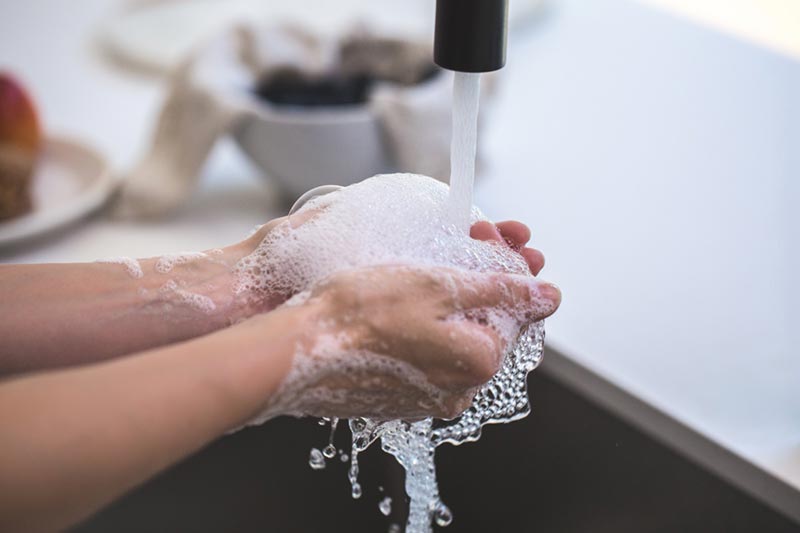
Everyone is worried about the coronavirus. Here’s what we know about avoiding the spread in your spa right now.
THIS ARTICLE WAS UPDATED MARCH 16, 2020, TO REFLECT THE LATEST INFORMATION. Much has changed since then and the information here may be no longer accurate:
We’re all concerned about COVID-19, a.k.a. the novel coronavirus, right now.
Late last year, this virus didn’t even exist, according to an article by Malia Jones, a social epidemiologist and demographer. Now it’s disrupting life all over the world, with a massive effect on the economy, particularly in travel and tourism, and experts are doing all they can to keep up and learn as much as possible in a very short time.
How worried should we be? Very worried. The WHO has declared a global pandemic and, all over the world, governments and health officials are calling for people to self isolate for the next several week in order to slow the spread.
Meanwhile, there’s a lot of terrifying news coverage, not much reassuring information, and just a lot we don’t know. We do know that we want to take care of our workers and minimize our risk. How best to do that if your spa remains open for business?
How is COVID-19 transmitted?
There is some debate over whether the novel coronavirus is airborne. Some say it is spread mostly through close contact and contaminated surfaces. Researchers at Queen Mary Hospital in Hong Kong, for example, conducted an experiment taking air samples from close to the mouth of a patient with a moderate level of viral load of coronavirus. “The virus was not detected in any of the tests, whether the patient was breathing normally, breathing heavily, speaking or coughing,” said a research brief. The findings were published March 5 in Infection Control & Hospital Epidemiology.
According to Stat News, however, there are conflicting reports on this topic, and there are studies suggesting that the coronavirus can exist as an aerosol in certain conditions.
As to the death rate, this is also a bit confusing. Malia Jones wrote that it is actually probably much lower than the estimated 3%. However, in some places it is much higher, and in Italy it was a stunning 7% as of March 15.
In the midst of all this uncertainty, however, life goes on. We have to work, run our spa and wellness businesses, and continue employing our team members, so they too can pay their bills and feed themselves and their families.
Public safety guidelines include hand washing and “social distancing”
Currently, the general public is advised to wash their hands frequently, use hand sanitizer regularly, avoid hugs and handshakes, and practise “social distancing,” which mean staying 3-6 feet apart from other people. The public is not advised to wear masks, as experts say these will not protect against infection, may increase a person’s chance of contracting the virus if not used correctly, and will cause a shortage of masks for the frontline healthcare workers in hospitals who actually need them. (If your employees are wearing masks, it’s a good idea to review their proper use, since masks should be properly fitted in order to work, and touching or adjusting the mask may affect their efficacy.) People who have the option of working from home are also being asked to do so in some areas.
There are some more basic protection measures from the ISPA website:
- Avoid touching eyes, nose and mouth.
- Cover your mouth and nose with your bent elbow or a tissue when you cough or sneeze, and encourage those around you to do the same.
- Stay home if you feel unwell. If you have a fever, cough and difficulty breathing, seek medical attention and call in advance.
Social distancing isn’t an option for spa service providers
Unfortunately, spa service providers don’t have the option to work from home or to practice social distancing. This leaves people vulnerable to both contracting and transmitting infectious diseases. To keep team members and guests safe, it’s likely time to review your infectious disease protocols and standards of practice, and hold team member meetings to go over these standards. Also, look to your local massage therapy colleges, aesthetician colleges, and/or governing bodies for best practice guidelines.
If you are not in a region currently experiencing an outbreak, ISPA also recommends that you do the following:
- Evaluate the cleaning frequency within treatment rooms and communal spaces and increase frequency if needed.
- Post signage reminding employees about hygiene standards (i.e. hand washing, wiping down equipment after use, covering coughs, etc.) and have the messaging posted in a visible spot for guests to see as well to generate awareness.
- Communicate reminders to guests and/or employees to wipe down fitness equipment before and after each use [in gyms and fitness spaces. It’s also a good idea to clean yoga mats after each use].
- Develop a plan for how to handle a health emergency including:
- Location of nearest medical facility. Identify a quarantine room/space in the event that it is needed.
- Identify an emergency plan on how to handle a situation if a guest or employee tests positive for COVID-19.
- Identify a communications/public relations plan on how to respond to a situation if a guest or employee tests positive for COVID-19.
Screening prior to treatment
Depending on your location, you may wind up needing to implement passive or active screening. “Active” screening means having guests answer questions related to exposure and symptoms of an infectious disease, while passive screening means placing signage around your place of business reminding guests of safety precautions (as stated above) and asking them to inform you of symptoms or travel to areas with high infection rates.
The Ontario College of Massage Therapists’ Standards of Practice for “Risk Identification and Management for an Outbreak of Infectious Diseases” include being aware of the symptoms of the infectious disease and interviewing clients to determine their risk of exposure. This should be done prior to entering the treatment area and providing treatment, if possible.
The standards state that clients who are at risk of exposure to, or of carrying, infectious disease should not be treated or should be treated in isolation.
Coronavirus prevention will likely be an ongoing process
Going forward, keep the dialogue open and communicate best practices with your team members. Stay informed on the latest developments about COVID-19 and any recommended changes in protocol.
If you offer paid sick leave, remind your employees to use it. If you don’t offer paid sick leave, you might want to consider doing so. People who can’t afford to miss work are, obviously, more likely to come to work sick and infect others.
Don’t panic
It doesn’t do anyone any good to panic. So, don’t.
Experts say that this is going to get worse, maybe a lot worse, before it gets better. And tourism will continue to be hit. If your business relies heavily on tourists, consider looking to local guests, to stay afloat, if your local guidelines are not currently recommending isolation. Try attracting new local guests and reconnecting with existing ones you haven’t seen in a while. Offer promotions in the form of packages, upgrades, or limited time loyalty points for products and services. And be sure to communicate all the safety protocols you’re following to your guests, so they know you’re taking their health seriously.
Being ready and able to answer the questions of your guests and team members will go a long way towards maintaining their confidence in you.
This too shall probably pass. Let’s all do our best to stay safe in the meantime.
 Sign up for Spa Executive’s newsletter and download the free report, Six Spa & Wellness Trends for 2020. CLICK HERE >>
Sign up for Spa Executive’s newsletter and download the free report, Six Spa & Wellness Trends for 2020. CLICK HERE >>
Spa Executive magazine is published by Book4Time, the world’s most innovative spa, salon, wellness, and activity management software. Learn more at Book4Time.com.



